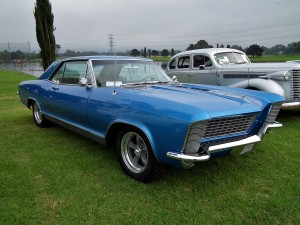Performance Brakes for Muscle Cars
By Justina Mathews

By sv1ambo (1965 Buick Riviera GS coupe) [CC BY 2.0 (http://creativecommons.org/licenses/by/2.0)], via Wikimedia Commons
You might have heard the old saying that before deciding to increase the horsepower of your vehicle, it is a good idea to bump up its stopping power. This is particularly true when it comes to muscle cars. Although muscle cars frequently come with gobs of V8 power, they are rarely champions at bringing all of that speed back down under control. You have to be even more wary of muscle cars from the 60s and 70s, which in some cases used drum brakes at all four corners.
Fortunately, there are some fairly inexpensive ways to improve the braking system of your car, and keep things from getting too out of hand at the end of the quarter mile. The first thing to start with is the brake pads. Stock brake pads are seriously incapable of handling high performance driving. The organic materials used in these types of pads are designed for low dust and long life perfect for a dealerships service department, but definitely not suited for giving you the bite on your brake rotors that you are looking for. It is very easy to exchange these for semi-metallic or ceramic brake pads, which cause more dust and are noisier, but which also dissipate heat much better. This means that there is less chance that the brakes will fade when you brake frantically while coming down a twisty mountain pass, ensuring consistent stopping power throughout a stretch of spirited driving.
You might want to add slotted or cross-drilled discs to your braking system as well. These types of discs have either etched grooves, or a pattern of holes drilled into them. Sometimes, they will have both. The theory behind this modification is that the slots and holes will help the brake to dissipate heat. On the street, you probably are not going to require this level of heat management, but if you like the look of this type of brake rotor, feel free to add it on as an aesthetic mod.
As mentioned above, if your muscle car harkens back to a bygone era, you are probably riding on drum brakes. These brakes are completely inadequate when it comes to stopping heavier performance machines, and are next to useless when mounted at all four wheels. There are several conversion kits available to add disc brakes to your cars front end, often using mounting hardware from similar models that came with the feature. Discs can also be added to the rear wheels. If you race your muscle car, then a disc brake conversion is a no-brainer.
Finally, while keeping on the subject of competition, brake fluid is something that you need to regularly change, particularly if you have been flogging your ride. Racing is hard on brake fluid, as the heat can cause it to vaporize and absorb moisture, making it less than effective. There are different types of performance brake fluids available with higher boiling points, making them excellent choices for track use. Make sure before you bleed and pour that any new brake fluid is compatible with your vehicles braking system as some types of fluid may have a detrimental effect on system hardware and seals.
About the Author
Justina Mathews writes issues that currently affect the performance car enthusiast. She also writes about issues that affect the street tuner industry, as well as import scene lifestyle. She’s a staff writer for fuel systems .
